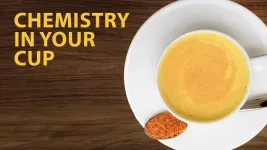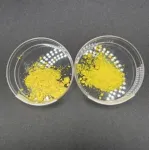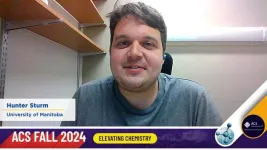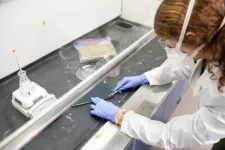The researchers will present their results at the fall meeting of the American Chemical Society (ACS). ACS Fall 2024 is a hybrid meeting being held virtually and in person Aug. 18-22; it features about 10,000 presentations on a range of science topics.
Golden milk — also called golden or turmeric latte — consists of milk, turmeric and spices, and is a good option for people who want to avoid caffeine or coffee or maybe enjoy a unique flavor. “It’s a very good beverage, especially if it’s cold outside, or if you’re sick,” explains Anthony Suryamiharja, a graduate student at the University of Georgia who’s presenting the research at the meeting. He says turmeric also features the bioactive compound curcumin — a polyphenol that has been studied for its potential anti-inflammatory and antioxidant effects. “If we can incorporate bioactive compounds like curcumin into plant-based milks to bring them up to the same nutritional level as cow’s milk, why not?” asks Suryamiharja.
Curcumin, however, is difficult to separate from turmeric, typically requiring complicated extraction techniques that involve organic solvents, multiple days and lots of energy. In addition, the compound tends to break down over time, shortening its shelf life. So, inspired by golden milk, Suryamiharja, Hualu Zhou and colleagues wanted to investigate whether there was a way to extract and store curcumin within plant-based milk.
They first added turmeric powder to an alkaline solution, where the high pH made the curcumin more soluble and easier to extract than in plain water. This deep red solution was then added to a sample of soy milk, turning it a dark yellow color. They brought it down to a neutral pH around 7. Just like low-pH acids, high-pH bases are not the most pleasant things to consume. The neutralized pseudo-golden milk could be enjoyed as-is, but to further preserve it, the team removed the water from the solution through freeze-drying, producing an instant golden milk powder.
Not only does the method extract curcumin from turmeric more efficiently than existing methods, but it also encapsulates the curcumin in oil droplets within the soy milk. This means that when consumed, our bodies recognize the curcumin as fat and digest it as such, theoretically making the curcumin more bioavailable, or likely to be absorbed and able to have an effect in the body. Encapsulating the curcumin also protects it from air and water, preserving it and keeping it shelf-stable for longer.
While this work focused specifically on soy milk because of its high amino acid content, the researchers say that it could be applied to other plant-based milks, providing options for those with allergies to soy. In addition, their pH-driven extraction method could be used on different plant compounds with similar ease and efficiency. For example, blueberries are rich in anthocyanins, another water-soluble polyphenol. “When we use the same method, within around a minute we can extract the polyphenols,” explains Zhou. “We want to try and use it to upcycle by-products and reduce the food waste from fruit and vegetable farming here in Georgia.”
Though more research is needed before their instant golden milk appears on store shelves, the researchers’ initial result is promising — Suryamiharja reports that it tasted good, despite not being a frequent golden latte enjoyer himself.
The team hopes that this work can help explain the chemistry behind what may seem like nothing more than a simple beverage, as well as improve that drink’s nutritional value and convenience for those who enjoy it. Suryamiharja explains that “people usually do a lot of simple things in the kitchen, but they don’t really realize there’s a chemistry behind it. So, we’re trying to explain those unspoken things in a simple way.”
The research received startup funding from the Department of Food Science & Technology at the University of Georgia.
A Headline Science video about this topic will be posted on Sunday, Aug. 18. Reporters can access the video during the embargo period, and once the embargo is lifted the same URL will allow the public to access the content. Visit the ACS Fall 2024 program to learn more about this presentation, “Utilizing a green pH-driven approach for developing curcumin-infused soymilk,” and other science presentations.
###
The American Chemical Society (ACS) is a nonprofit organization chartered by the U.S. Congress. ACS’ mission is to advance the broader chemistry enterprise and its practitioners for the benefit of Earth and all its people. The Society is a global leader in promoting excellence in science education and providing access to chemistry-related information and research through its multiple research solutions, peer-reviewed journals, scientific conferences, eBooks and weekly news periodical Chemical & Engineering News. ACS journals are among the most cited, most trusted and most read within the scientific literature; however, ACS itself does not conduct chemical research. As a leader in scientific information solutions, its CAS division partners with global innovators to accelerate breakthroughs by curating, connecting and analyzing the world’s scientific knowledge. ACS’ main offices are in Washington, D.C., and Columbus, Ohio.
Registered journalists can subscribe to the ACS journalist news portal on EurekAlert! to access embargoed and public science press releases. For media inquiries, contact newsroom@acs.org.
Note to journalists: Please report that this research was presented at a meeting of the American Chemical Society. ACS does not conduct research, but publishes and publicizes peer-reviewed scientific studies.
Follow us: X, formerly Twitter | Facebook | LinkedIn | Instagram
Title
Utilizing a green pH-driven approach for developing curcumin-infused soymilk
Abstract
With the global population projected to reach approximately 10 billion by 2050, there is a urgent need for sustainable, healthy, and affordable next-generation foods to meet increasing demand. However, fully harnessing the potential of plants to enhance the sustainability and health benefits of plant-based ingredients or foods remains challenging, particularly in the absence of efficient and cost-effective processing methods. In this study, we developed a novel two-in-one approach, termed the post pH-driven (PPD) method, to simultaneously extract and encapsulate curcumin in plant-based milks. This innovative technique offers a highly efficient and economical means of incorporating bioactive curcumin or turmeric for enhanced health benefits. Using soy milk as a model system, we initially dissolved curcumin or turmeric in an aqueous extraction solution. Subsequently, the dissolved compounds were directly encapsulated into the hydrophobic phase of soymilk. Finally, the mixture was processed into milk powder, achieving exceptional extraction and encapsulation efficiencies of approximately 100% for curcumin and 80% for turmeric. The slightly lower efficiency observed for turmeric can be attributed to the fact that only approximately 80% of curcumin was extracted, while its encapsulation efficiency approached 100%. Moreover, the resulting curcumin-infused milk powder exhibited high water solubility due to the encapsulation of curcumin within the hydrophobic phase of soymilk. Additionally, the chemical stability of curcumin was significantly enhanced. The successful infusion of curcumin or turmeric can be attributed to the rapid and efficient processing enabled by the PPD approach. Moreover, this method is noteworthy for its avoidance of organic solvents and sophisticated equipment, resulting in a reduced environmental footprint. Overall, the PPD approach holds significant promise for driving innovation in the development of plant-based foods.
END








